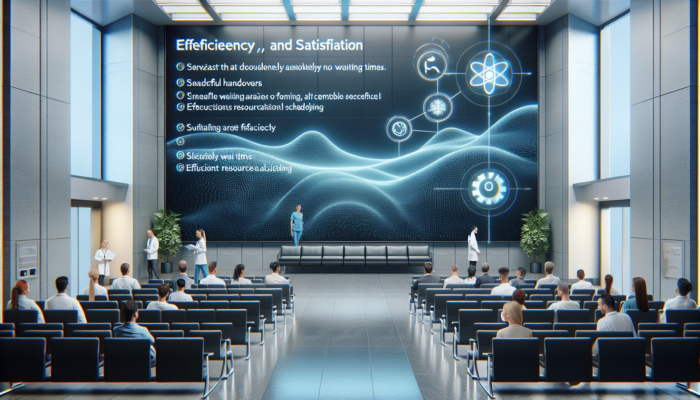Automation for Scaling Your Healthcare Business Effectively
Maximize Growth in Your Healthcare Business by Leveraging Automation Strategies
Comprehending Automation in Healthcare: Essential Concepts and Definitions

Automation in the healthcare sector represents a revolutionary strategy that employs advanced technology to boost operational efficiency and elevate patient outcomes. By automating routine and repetitive tasks, healthcare organizations can optimize workflows, minimize human error, and allocate resources more judiciously. This broad process encompasses various functions including appointment scheduling, billing, patient data management, and communication systems. Grasping the intricate details of automation in healthcare is vital, as it often leads to remarkable enhancements in both service delivery and overall business performance.
At its core, the principle of automation involves the seamless integration of technology into daily operations. This could mean adopting sophisticated software solutions that facilitate electronic health records (EHR), billing, and patient engagement. By centralizing critical data, healthcare providers gain instant access to essential information, which empowers them to make well-informed clinical decisions. Additionally, automation alleviates administrative burdens, allowing healthcare professionals to devote more time to patient care rather than getting bogged down by paperwork.
Moreover, automation significantly enhances patient safety. By minimizing the likelihood of human error through automated systems, healthcare providers can ensure accurate medication administration and treatment compliance. Automated reminders can also assist in keeping patients on track with their appointments and medication schedules, thereby improving health outcomes and overall patient satisfaction. The cornerstone of successful automation is recognizing its potential to streamline operations while remaining committed to delivering quality care.
Pinpointing Opportunities for Automation: Effective Strategies to Begin
To successfully implement automation in your healthcare operations, conducting a thorough assessment of existing workflows is essential. Begin by identifying repetitive tasks and processes that take up significant time and resources. Common areas that are particularly suited for automation include appointment scheduling, patient follow-ups, billing processes, and documentation management. By recognizing these opportunities, you can formulate a strategic approach to automation that maximizes efficiency and minimizes operational costs.
An organized approach starts with mapping out current workflows. Involve your staff in this evaluation process, as they can provide valuable insights into daily operations and identify existing pain points. Once you have pinpointed these areas, prioritize the tasks that will have the most significant impact on operational efficiency and patient care. For example, automating appointment scheduling can greatly reduce no-show rates and improve patient flow, while streamlining billing can decrease errors and enhance cash flow.
Consider also the scale of automation you intend to achieve. Initiate small pilot projects that demonstrate quick wins, and gradually expand your efforts based on feedback and results. This phased implementation fosters confidence among staff and stakeholders, illustrating the tangible benefits of automation. By concentrating on sectors where automation can deliver the most substantial impact, you position your healthcare organization for scalable growth.
Establishing Clear Objectives: Define Your Desired Outcomes
Clearly defining specific objectives for your automation initiatives is crucial for their success. Start by setting measurable goals that align with your overall business strategy. Your objectives might encompass reducing operational costs, enhancing patient care quality, improving patient engagement, or increasing overall scalability. Having distinct targets enables you to evaluate the effectiveness of your automation efforts and make necessary adjustments to stay on course.
When determining your objectives, consider the unique challenges your healthcare organization faces. If high administrative costs pose a significant hurdle, your goal may focus on reducing these through the implementation of automation. Alternatively, if patient satisfaction scores are lacking, your efforts may center on integrating tools that enhance communication and engagement with patients. By aligning your automation goals with specific organizational challenges, you create a more targeted and impactful strategy.
Furthermore, involving your team in the goal-setting process is vital. Engaging staff in discussions about desired outcomes fosters a sense of ownership and commitment to the automation initiatives. Regularly revisiting and refining these goals ensures that your automation strategy remains dynamic and adaptable to changing needs within your healthcare organization. Ultimately, clear objectives serve as a guiding framework, steering your organization towards successful automation and growth.
The Impact of Technology on Scaling Your Healthcare Business Through Automation

Harnessing Electronic Health Records (EHR) and Patient Management Systems
The implementation of Electronic Health Records (EHR) stands as a foundational element of healthcare automation, offering a streamlined method for managing patient information. EHR systems centralize patient data, allowing healthcare providers to access it in real-time. This accessibility not only enhances the quality of care but also boosts operational efficiency by reducing the administrative workload associated with traditional paper records.
By adopting EHR systems, healthcare organizations can significantly improve patient management processes. For instance, appointment scheduling becomes more efficient as patients have the option to book online, receive automated reminders, and access their health records whenever needed. This not only optimizes the patient experience but also alleviates the burden on administrative staff, enabling them to focus on more complex tasks. Furthermore, EHR systems enhance communication and collaboration among healthcare providers, ensuring all team members have access to the most current patient information.
An additional advantage of EHR systems lies in their ability to support data analytics. By aggregating patient data, healthcare organizations can analyze trends and outcomes, leading to informed decision-making. This data-driven approach facilitates more personalized care, as providers can recognize specific patient needs and tailor their treatment plans accordingly. Implementing EHR systems is not merely a technological upgrade; it represents a strategic shift towards enhancing patient care and boosting operational performance.
Utilizing Telemedicine and Remote Patient Monitoring for Enhanced Care
Telemedicine has emerged as a groundbreaking tool in the healthcare sector, enabling providers to extend their services beyond traditional clinical environments. By utilizing telemedicine platforms, healthcare organizations can offer consultations, follow-ups, and patient education remotely, thereby making healthcare more accessible to individuals in underserved areas. This transformation not only broadens the patient base but also significantly enhances patient satisfaction by minimizing travel time and reducing wait periods.
Remote patient monitoring (RPM) complements telemedicine effectively, allowing healthcare providers to track patients’ health metrics from a distance. Devices such as smartwatches and health monitors can gather data on vital signs, medication adherence, and overall health status. This information can be transmitted directly to healthcare providers, facilitating proactive management of chronic conditions and timely interventions as required. For example, a patient with diabetes can be closely monitored for blood sugar levels, allowing for immediate treatment adjustments based on real-time data.
Integrating telemedicine and RPM into your healthcare automation strategy can yield substantial benefits, including enhanced patient engagement and improved health outcomes. Moreover, these technologies can help mitigate staffing shortages by allowing healthcare professionals to manage larger patient volumes efficiently. As the demand for healthcare continues to surge, incorporating telemedicine and remote monitoring solutions positions your organization for sustainable growth and scalability.
Advancing with Artificial Intelligence and Machine Learning Applications

Artificial Intelligence (AI) and Machine Learning (ML) are at the cutting edge of innovation in healthcare automation, offering impactful tools for data analysis and strategic decision-making. By employing AI algorithms, healthcare organizations can process extensive amounts of data to uncover insights that lead to improved patient outcomes. For instance, AI can evaluate patient histories and recognize patterns that inform tailored treatment strategies, thus elevating the quality of care.
Machine Learning, a branch of AI, empowers systems to learn from data inputs and improve autonomously over time without explicit programming. This capability is particularly beneficial in predictive analytics, where ML can anticipate patient needs and outcomes based on historical data. For example, ML algorithms can forecast which patients are at risk of hospitalization based on their medical history and current health status, enabling timely interventions that can prevent complications.
Incorporating AI and ML applications into your healthcare automation strategy enhances clinical decision-making and optimizes operational efficiency. For instance, AI-driven chatbots can manage routine patient inquiries, freeing up staff to concentrate on more complex issues. Additionally, these technologies can assist in resource allocation by predicting patient volumes and adjusting staffing levels accordingly. As the healthcare landscape continues to evolve, embracing AI and ML will be critical for organizations aiming to scale effectively and maintain a competitive edge.
Overcoming Hurdles in Scaling Your Healthcare Business via Automation
Mitigating Staff Concerns and Resistance to Change
Implementing automation in healthcare often encounters resistance from staff, who may fear job loss or struggle to adapt to new technologies. To effectively address these concerns, clear communication about the benefits of automation is essential. Emphasize how automation can alleviate mundane tasks, allowing healthcare professionals to dedicate more time to patient care and engage in more fulfilling responsibilities.
Engaging staff in the automation process is paramount. Involve them in discussions about the changes being introduced, and invite their feedback and suggestions. This collaborative method fosters an inclusive culture and helps staff feel valued during the transition. Providing comprehensive training sessions on new technologies is crucial, as it equips staff with the necessary skills to utilize automation tools effectively. By addressing concerns directly and facilitating a smooth transition, you can reduce resistance and encourage staff to embrace automation.
Additionally, sharing success stories from other healthcare organizations can help alleviate fears by demonstrating the positive impact of automation on operational efficiency and patient care. By showcasing real-world examples of how automation has enhanced workflows and improved job satisfaction, you can inspire confidence within your team. Ultimately, addressing staff concerns with transparency and support is a vital step toward successfully scaling your healthcare business with automation.
Prioritizing Data Security and Patient Privacy
As healthcare organizations adopt automation technologies, safeguarding patient data and ensuring privacy must remain a top priority. The integration of electronic systems increases the risk of data breaches and cyberattacks, making robust cybersecurity measures essential. Implementing multi-layered security protocols, including encryption, firewalls, and access controls, can protect sensitive patient information from unauthorized access.
Regular staff training on data security best practices is crucial in creating a culture of awareness and responsibility. Employees should be educated on recognizing phishing attempts, securing passwords, and understanding the implications of data breaches. Additionally, conducting regular risk assessments can help identify vulnerabilities within your systems, enabling proactive measures to mitigate potential threats.
Furthermore, compliance with regulations such as the General Data Protection Regulation (GDPR) and the Health Insurance Portability and Accountability Act (HIPAA) is non-negotiable. Ensuring that your automation solutions adhere to these guidelines not only protects patient data but also shields your organization from legal repercussions. By prioritizing data security and patient privacy, you can foster trust among your patients while effectively scaling your healthcare business through automation.
Navigating Regulatory Compliance and Legal Considerations
The healthcare landscape is heavily regulated, and navigating compliance can present significant challenges when scaling your business with automation. Understanding the legal implications of implementing automation technologies is imperative to avoid costly penalties and ensure the protection of patient rights. Familiarize yourself with relevant regulations, such as HIPAA and GDPR, which govern patient data privacy and security.
Engaging legal counsel with expertise in healthcare compliance can provide valuable guidance in ensuring your automation initiatives align with regulatory requirements. This includes evaluating the legality of data-sharing practices, consent protocols, and patient rights in an automated environment. Additionally, consider the implications of automation on billing and coding processes, as errors in these areas can lead to compliance issues and financial losses.
Regular audits of your automation systems are essential to assess compliance and identify any areas requiring improvement. By staying informed about regulatory changes and actively monitoring your automation practices, you can mitigate risks and ensure that your healthcare business remains compliant as it scales. Ultimately, a proactive approach to regulatory compliance not only safeguards your organization but also reinforces your commitment to maintaining high standards of patient care.
Success Stories: Exemplifying Automation in Scaling Your Healthcare Business
Hospital X: Transforming Operations and Cutting Costs
Hospital X serves as an exemplary case of successfully implementing automation to streamline operations and reduce costs. Faced with rising administrative expenses, the hospital adopted an automated scheduling system that transformed how appointments were managed. By enabling patients to book appointments online and receive automated reminders, Hospital X significantly reduced no-shows and optimized the patient flow throughout its facilities.
The impact on operational efficiency was tremendous. Administrative staff could concentrate on more complex tasks, leading to a 20% reduction in overall administrative costs. Moreover, patient satisfaction scores improved, as individuals experienced shorter wait times and more accessible appointment scheduling. This case highlights how strategic automation can result in substantial cost savings while enhancing the patient experience—a win-win scenario for both the hospital and its patients.
In addition to appointment scheduling, Hospital X streamlined its billing processes through automation. By integrating electronic billing systems, the hospital minimized errors and expedited claims processing. This not only improved cash flow but also alleviated the administrative burden on staff, allowing them to dedicate more time to patient care. Hospital X’s success underscores the transformative power of automation in enhancing operational efficiency and driving cost savings within healthcare organizations.
Clinic Y: Enhancing Patient Experience and Satisfaction
Clinic Y’s journey toward automation illustrates the potential of technology to enrich patient experience and enhance satisfaction. Recognizing the need for improved communication with patients, Clinic Y implemented a patient portal that allowed individuals to access their health records, schedule appointments, and communicate with healthcare providers seamlessly. This shift empowered patients to take greater control of their healthcare journey, leading to improved engagement and higher satisfaction levels.
Feedback from patients was overwhelmingly positive, with many appreciating the convenience of accessing their health information online. As a result, Clinic Y experienced a notable increase in patient satisfaction scores, positioning itself as a leader in patient-centric care within its community. The use of automated communication tools also enabled the clinic to send personalized reminders for appointments and follow-ups, further enhancing the patient experience.
Moreover, the patient portal facilitated better continuity of care, as patients could easily share their health information with multiple providers. This improved collaboration among healthcare professionals led to more coordinated and effective treatment plans. Clinic Y’s success story underscores the importance of prioritizing patient-centric automation solutions to enhance the overall quality of care and drive positive patient outcomes.
Practice Z: Growing Services and Boosting Revenue
Practice Z capitalized on automation to expand its services and significantly increase revenue through telemedicine. Recognizing the growing demand for accessible healthcare, the practice adopted a telemedicine platform that allowed healthcare providers to conduct virtual consultations with patients. This innovative approach not only broadened the practice’s reach but also catered to patients who faced barriers to in-person visits.
As a result of implementing telemedicine, Practice Z reported a 30% increase in patient volume within the first year. The convenience of virtual consultations attracted new patients, while existing patients appreciated the flexibility and accessibility of care. Additionally, telemedicine enabled the practice to offer specialized services that were previously unavailable due to geographical constraints.
The financial benefits of telemedicine extended beyond increased patient volume. By automating the appointment booking and billing processes associated with virtual visits, Practice Z reduced administrative overhead and improved revenue cycle management. This case exemplifies how embracing automation can drive growth and innovation in healthcare, positioning organizations for long-term success in a rapidly evolving industry.
Evaluating the Impact of Scaling Your Healthcare Business via Automation
Essential Key Performance Indicators (KPIs) for Measuring Automation Success
To assess the effectiveness of your automation initiatives, establishing clear Key Performance Indicators (KPIs) is essential. These metrics provide valuable insights into how automation impacts your healthcare business, allowing you to track progress towards your objectives. Common KPIs for measuring automation success include cost savings, patient satisfaction, staff productivity, and overall operational efficiency.
Tracking cost savings is a crucial aspect of evaluating the financial impact of automation. By comparing expenses before and after automation, healthcare organizations can quantify the return on investment (ROI) associated with their initiatives. Additionally, monitoring patient satisfaction scores through surveys and feedback mechanisms can provide insights into how automation has improved the patient experience.
Staff productivity is another vital KPI to consider. Measuring the time saved through automation can help determine how effectively staff can focus on higher-value tasks. Furthermore, analyzing operational efficiency metrics, such as appointment wait times and processing times for billing, can highlight improvements resulting from automation. By continuously monitoring these KPIs, your healthcare organization can make informed decisions about future automation initiatives and necessary adjustments.
Conducting Regular Audits and Assessments for Continuous Improvement
Regular audits and assessments of your automation systems are essential for identifying areas for improvement and optimization. These evaluations enable healthcare organizations to ensure that their automation technologies align with strategic goals and continue to deliver value over time. Conducting periodic reviews helps identify potential performance gaps and opportunities for further enhancement.
During audits, assess the effectiveness of your automation processes by analyzing workflow efficiency, data accuracy, and user satisfaction. Engaging staff in these assessments can provide valuable insights, as they are often the best source of information on how automation tools function in practice. Collecting feedback from both staff and patients can highlight areas where improvements can be made, ensuring that your automation strategy remains responsive to their needs.
Additionally, staying informed about advancements in automation technology and industry best practices is crucial. As new tools and solutions emerge, regularly evaluating your existing systems can help ensure that your healthcare organization remains competitive and efficient. By committing to ongoing assessments, you can optimize your automation initiatives and drive continuous improvement within your healthcare business.
Gathering Feedback from Patients and Staff to Enhance Automation
Collecting feedback from patients and staff is a critical component of measuring the impact of automation on your healthcare organization. Engaging stakeholders in conversations about their experiences with automated systems can provide valuable insights into what is working well and what may require adjustment. Implementing regular feedback mechanisms, such as surveys, focus groups, or suggestion boxes, can facilitate open communication and encourage participation.
Patient feedback is particularly vital for understanding the real-world impact of automation on the healthcare experience. By soliciting input on aspects such as appointment scheduling, communication, and overall satisfaction, you can gauge how effectively automation meets patient needs. This information can inform future enhancements and ensure that automation initiatives remain patient-centric.
Similarly, staff feedback offers insights into the effectiveness of automation tools in supporting their workflows. By understanding how automation affects staff productivity, job satisfaction, and overall morale, healthcare organizations can make informed decisions about future investments in technology. Creating an environment where feedback is encouraged fosters a culture of continuous improvement and demonstrates a commitment to both patient care and employee wellbeing.
Emerging Trends in Scaling Your Healthcare Business Through Automation
Embracing Predictive Analytics and Personalized Medicine in Healthcare
The future of healthcare automation is poised to be greatly influenced by predictive analytics and personalized medicine. Predictive analytics utilizes data and algorithms to forecast patient outcomes and trends, empowering healthcare providers to make data-driven decisions regarding treatment options. By identifying high-risk patients and predicting potential complications, healthcare organizations can tailor interventions that enhance overall patient outcomes.
Personalized medicine, on the other hand, focuses on individual patient characteristics, preferences, and genetic makeup to inform treatment strategies. This approach allows healthcare providers to deliver more targeted therapies, thereby enhancing the effectiveness of interventions while minimizing adverse effects. The integration of predictive analytics with personalized medicine has the potential to transform patient care, leading to more tailored and efficient healthcare delivery.
As automation technologies continue to evolve, the ability to harness vast amounts of patient data will become increasingly essential. By investing in predictive analytics capabilities, healthcare organizations can enhance clinical decision-making, optimize resource allocation, and ultimately improve patient care. Embracing these trends positions your healthcare business at the forefront of innovation and prepares you for the future landscape of healthcare.
Integration of Internet of Things (IoT) Devices in Healthcare Automation
The integration of Internet of Things (IoT) devices into healthcare automation strategies is rapidly gaining traction. IoT devices, such as wearables and smart medical equipment, enable continuous monitoring of patients’ health metrics and facilitate real-time data transmission to healthcare providers. This constant flow of information empowers healthcare organizations to deliver proactive and timely interventions, ultimately enhancing patient outcomes.
For example, IoT devices can monitor vital signs, activity levels, and medication adherence, allowing healthcare providers to track patients remotely. This capability is especially beneficial for managing chronic conditions, as it allows for early detection of potential complications. By harnessing the power of IoT, healthcare organizations can enhance patient engagement, improve adherence to treatment plans, and streamline communication between patients and providers.
The adoption of IoT devices also supports operational efficiency by enabling remote patient monitoring and reducing the need for in-person visits. This not only alleviates the burden on healthcare facilities but also provides patients with greater flexibility and convenience. As the adoption of IoT devices continues to grow, healthcare organizations that embrace this technology will be well-positioned to scale their operations and improve the quality of care delivered.
Exploring the Potential of Blockchain Technology in Healthcare Automation
Blockchain technology holds immense potential for transforming healthcare automation by providing secure and transparent data management solutions. By leveraging decentralized ledgers, healthcare organizations can enhance data integrity and security, ensuring that patient information is protected from unauthorized access and tampering. This is particularly crucial in an era where data breaches are becoming increasingly common.
The use of blockchain can streamline processes such as patient data sharing, consent management, and supply chain tracking. By enabling secure data exchanges between healthcare providers, patients, and insurers, blockchain technology can facilitate more efficient collaboration and coordination of care. For instance, patients can have greater control over their health data, granting access only to authorized parties while maintaining a clear audit trail of who accessed their information.
Moreover, blockchain can enhance the traceability of pharmaceuticals and medical devices within the supply chain, reducing the risk of counterfeit products entering the market. As healthcare organizations continue to scale their automation efforts, integrating blockchain technology will be essential for ensuring data security and compliance with regulatory requirements. Embracing this innovative approach positions your healthcare business at the forefront of technological advancements, paving the way for future growth and success.
Scaling Your Healthcare Business Through Automation: Frequently Asked Questions and Expert Insights
What Advantages Can Small Healthcare Practices Gain from Automation?
Small healthcare practices can derive significant benefits from automation by alleviating administrative burdens and streamlining workflows. Automation enables them to concentrate on delivering high-quality patient care while simultaneously enhancing operational efficiency, ultimately leading to improved patient outcomes and overall satisfaction.
What Are Common Pitfalls to Avoid When Implementing Automation?
Common pitfalls include rushing into automation without comprehensive planning and neglecting to involve staff in decision-making processes. It is essential to assess needs, establish clear objectives, and engage team members to ensure a successful implementation and buy-in.
How Can Automation Help Mitigate Staffing Shortages in Healthcare?
Automation can address staffing shortages by automating routine tasks such as appointment scheduling and billing, allowing staff to focus on more complex responsibilities. This efficiency enables healthcare providers to manage larger patient volumes with the resources they currently possess.
Which Key Areas Are Most Suitable for Automation Implementation?
Key areas for automation include appointment scheduling, billing and coding processes, patient data management, and communication. Identifying repetitive tasks in these domains can lead to significant efficiency gains and cost reductions.
What Role Does Training Play in Successful Automation Implementation?
Training is vital for the successful implementation of automation. It equips staff with the necessary skills to utilize new technologies effectively, fosters confidence, and minimizes resistance to change, ultimately ensuring a seamless transition.
How Can Patient Feedback Enhance Automation Initiatives?
Patient feedback provides invaluable insights into the effectiveness of automation efforts. By understanding patient experiences and preferences, healthcare organizations can make informed adjustments to enhance patient satisfaction and the quality of care provided.
What Is the Importance of Data Security in Healthcare Automation?
Data security is imperative in healthcare automation to safeguard sensitive patient information and comply with pertinent regulations. Implementing robust security measures protects against breaches and helps build trust with patients and stakeholders.
How Can Automation Enhance Telemedicine Initiatives?
Automation supports telemedicine by streamlining appointment scheduling, billing, and communication with patients. This improves operational efficiency and enables healthcare providers to expand their reach, thus offering care to more patients.
What Future Trends Should Healthcare Organizations Monitor?
Healthcare organizations should pay attention to trends in predictive analytics, IoT integration, and blockchain technology. These advancements will shape the future of healthcare automation, enhancing patient care and operational efficiency.
How Can Automation Boost Financial Performance in Healthcare?
Automation can enhance financial performance by reducing administrative costs, minimizing billing errors, and optimizing revenue cycle management. This can result in improved cash flow and overall profitability for healthcare organizations.

































